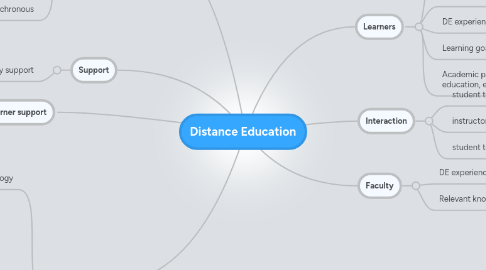Distance Education
by S. Newsome Taylor


1. Learner support
1.1. Institutional support
1.2. Academic support (i.e. tutoring)
2. Resources
2.1. Technology
2.1.1. Print
2.1.2. Audio
2.1.3. Video
2.1.4. Computer
2.2. Instructional materials
2.2.1. Learning Activiies
2.2.2. Assignments
2.2.3. Projects
2.2.4. Assessments
2.3. Research materials
2.3.1. Electronic databases
2.3.2. "brick and mortar" library
2.3.3. Learning community
2.3.4. Internet
3. Support
3.1. Faculty support
3.1.1. Technology training
3.1.2. Academic professional development
4. Communication
4.1. Asynchronous
4.1.1. Email
4.1.2. Message boards
4.1.3. Blogs
4.1.4. Wikis
4.1.5. Social networking
4.2. Synchronous
4.2.1. Instant messaging
4.2.2. Video conferencing
4.2.3. Phone calls
5. Learners
5.1. Age
5.2. geographical location
5.3. DE experience
5.4. Learning goals/motivation
5.5. Academic path (certificate, degree, continuing education, etc.)
6. Faculty
6.1. DE experience
6.2. Relevant knowledge/expertise
7. Interaction
7.1. student to student
7.1.1. collaborative learning activities
7.2. instructor to student
7.2.1. feedback, guidance
7.3. student to instructor
7.3.1. tutoring, additional assistance
